I have used Amazon affiliate links on this page. As an Amazon Associate, I earn a commission from qualifying purchases at no added cost to you. Thank you!

Table of Contents
Introduction to True Parrot Cichlid

The True Parrot Cichlid is not just another pretty face. It is indeed the pure parrot cichlid from the Orinoco and Negro river basins of South America. the scientific name of True Parrot Cichlid is Hoplarchus Psittacus. However, it’s commonly confused with a number of hybrid “parrot” cichlids, such as the blood or red parrot. But, this is an uncommon fish, so make sure you’re buying the real deal from a reputable source.
This large South American cichlid species matures to spectacular blue, green, olive, and turquoise coloration.
Also known as True Parrotfish, is notable for its distinctive face marking, which resembles a parrot’s beak. It is found in slow-moving water bodies like ponds, lakes, and rivers in South America. In the wild, the water bodies they live in are slightly acidic and warmer. Hence given such conditions you get the full-color display for this cichlid.
Scientific Naming of True Parrot Cichlid
Hoplarchus psittacus or the true parrot cichlid is the single species contained by the genus Hoplarchus. So it’s indeed a unique fish in scientific terms. As mentioned beforehand, this fish is endemic to blackwater river habitats in Colombia, Venezuela, and Brazil. They are common in the upper Orinoco, Rio Negro, and Urubu rivers. Locally these fish are considered food fish.
The temperament of True Parrot Cichlid
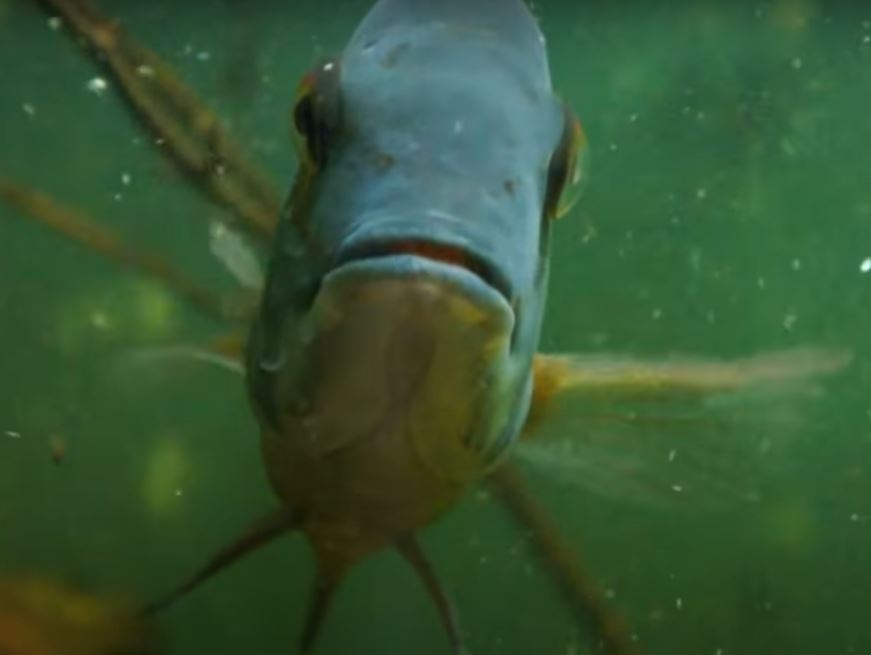
The True Parrot Cichlid is a stunning fish that should be in the center of attention in any aquarium. A bright, large tank is the perfect home for this large fish with some plants for support. It loves to swim around, and can even jump when getting excited. It’s best to add other cichlids that match up to their size because as an adult is quite territorial.
This large Cichlid is a very aggressive and territorial fish, which means that it should only be kept with other equally aggressive cichlids or large, territorial species. Don’t even try to add small invertebrates, as the true parrot cichlid will eat them like it’s a buffet! You may try with larger ornamental invertebrates but only if the invertebrates are powerful and strong enough to defend themselves from this fish. But I wouldn’t try that…
Tankmates
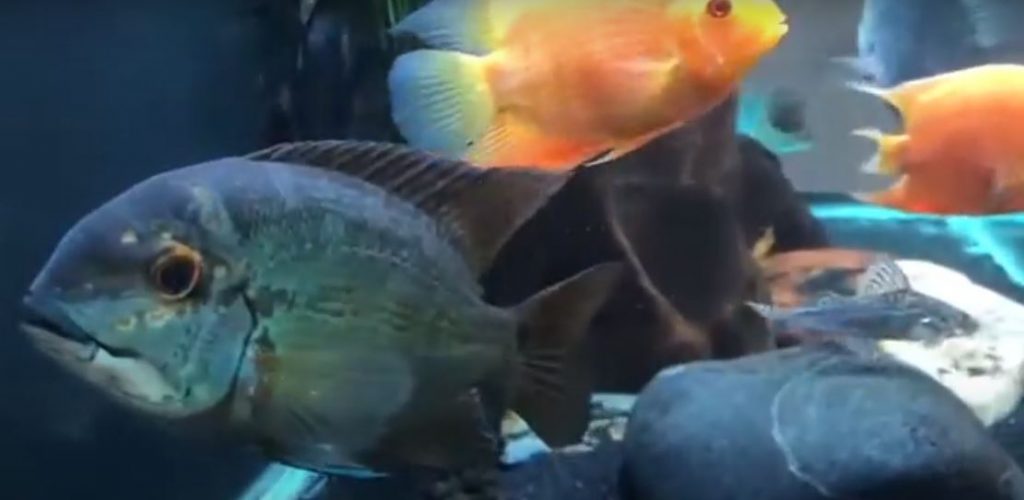
These fish needs to be coupled with similar or larger size aggressive cichlids, for instance, fishes like the large eartheaters, acaras, Large Oscars, Uaru, and severums.
As mentioned above, the smaller fish will be eaten, so don’t take the risk of testing! Even though they might look nice to other small fish and invertebrates during the day, make sure that you never leave your True Parrot Cichlids alone with them. These are big fish, and they can and will eat anything smaller than their mouth with no hesitation!.
True Parrot Cichlid Size
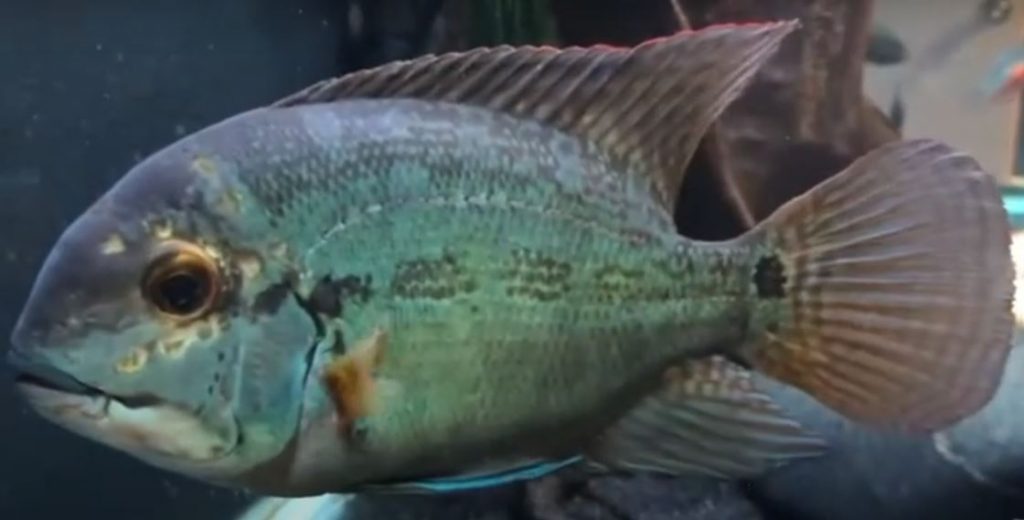
On average, adult true parrots range from 10 to 14 inches long. They are lighter in color than many other parrotfish species and can grow up to 18 inches, but it’s rare for them to do so. These fish tend to live in deeper areas where they can find plenty of food.
Are you interested in smaller to medium size cichlids as well? Then you must read about Red Empress Cichlid and Polar Blue Parrot Cichlid.
Lifespan
The average life span for Hoplarchus psittacus or true parrot cichlid is about 10 years if the best living conditions are provided.
Water Parameters
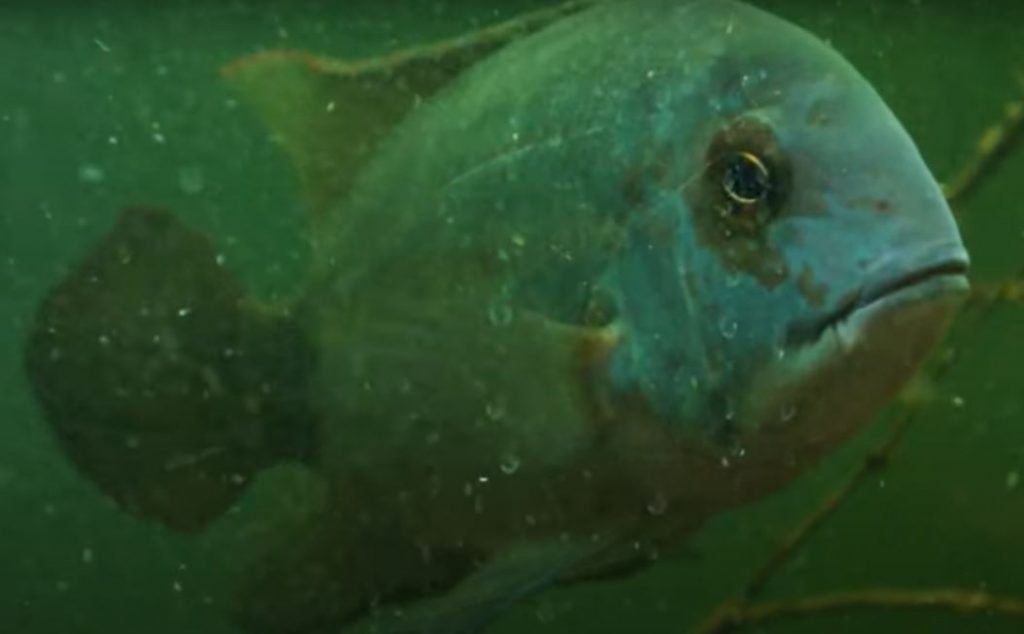
True Parrot Cichlids have evolved over time to be a very resilient species. Thus, this species can thrive in a wide range of water parameters. As long as the fish is kept at a consistent pH level, it will adapt to changing environments.
But this fish is sensitive to ammonia. So it’s better to have a good filtration system to break down ammonia and nitrites.
Like other tropical fish, the true parrot cichlid needs to be kept in aquariums that mimic their natural ecosystems. They live in South America, where river water has an average temperature of 80 degrees Fahrenheit (27 degrees Celsius). And the water is a bit acidic in their natural habitat. So keeping the water at a similar temperature is critical for their health and lifespan.
Below are the recommended water parameters for the true parrot cichlid
- Temperature: 79° – 86° F (26° – 30° C)
- pH: 5.5 – 6.5
- carbonate hardness (KH): 2 – 12 KH
The diet of True Parrot Cichlid
There are many factors that determine how the Parrot Cichlids feed. One is their natural habitat: the rivers and lakes of South America. In this environment, they are constantly on the move to find food, searching both under rocks and water plants. This type of activity means they expend a lot of calories. As a result, they need a high-protein diet with adequate amounts of fats and other nutrients that increase energy intake.
True Parrot Cichlids are voracious eaters, and will eagerly consume most foods offered. However, it’s important to provide high-quality, diverse foods to maintain their vibrant colors and overall health.
These fish are among the easiest fish in an aquarium to feed. They will accept almost any type of food, whether live, frozen, or dry in both large and small sizes. Such as, frozen shrimp, earthworms, frozen bloodworms, and other foods of that nature. They can also eat dried crickets and blackworms if they’re feeling a little frisky. Just about anything that falls onto the floor can also become dinner for these voracious predators. A mixed diet is also important for maintaining the overall health and coloration of the fish.
As with other pet fish species, don’t feed them live food unless it’s super necessary. The feeder fish you buy isn’t healthy like the natural prey these fish find in the wild. The feeders are often bred and raised in such artificial and cramped conditions that they tend to carry more parasites, bacteria, and viruses than wild prey fish.
Required Tank Size for True Parrot Cichlid

This is a relatively large Cichlid, so it demands bigger tanks. Enough space minimizes the competition between their own kind and helps regulate the water parameters. Given this fish eats a lot the water can go bad within hours if not cared for.
Below are the minimum tank sizes for the true parrot cichlid:
100 gallons for 1 fully grown true parrot cichlid.
150+ gallons for a pair of fully grown true parrot cichlids.
Providing Natural Habitat
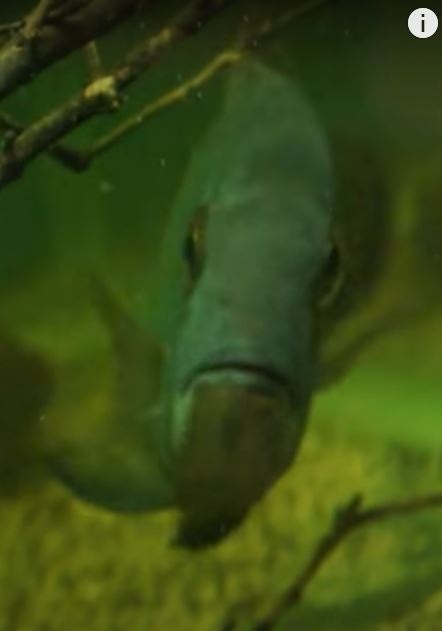
Given the right environment, a true Parrot Cichlid will thrive. A suitable aquarium should have smooth sand and gravel mixed substrate. Add some driftwood, natural rocks to match up to their natural habitat. You can add live plants too. All these are natural elements of their black water habitat in South America. Live plants should be sturdy enough to withstand the swimming power of the Parrot Cichlid and be attached to driftwood or rocks. Remember that these are powerful fish that can mess with your nice aquascape.
If you are able to replicate their natural habitat the true parrot cichlid will display their natural behavior. Then you end up with a happy and stress-free fish. This can greatly benefit raising healthier fish.
Breeding true parrotfish
Parrot cichlids are among the most challenging South American cichlid species to breed. These fish are bi-parental substrate spawners, which means that they lay their eggs on a solid surface instead of in open water.
True parrots are sexually isomorphic fish species. So it’s really difficult to identify females and males. However, you may identify the gender by looking at the male true parrot fish’s highlighted fatty hump. Moreover, the females are a bit smaller than the males.
It is best to buy a group of little true parrot cichlids; a breeding pair will emerge in time. They get sexual maturity at about 3 years of age. Once a pair has formed them into a breeding tank. You could alternatively leave them in the main tank and move the rest of the occupants. The latter isn’t recommended though.
True parrotfish breeding triggers
You may raise the aquarium water temperature up to 84° to 86°F kick start their mating instincts. Lowering the PH by adding some RO water has brought some good results as well.
Make sure to heavy feed the pair to trigger their breeding instincts, especially in females.
The mating ritual of True Parrot Cichlid
After biting, nipping, and chasing each other around for a bit, the female parrot cichlid will lay a few hundred eggs usually up to 300, on a rock or on a flat surface of the aquarium. And the male will immediately follow suit to fertilize the eggs with its genes. The parents look after the eggs and fry after they hatch. They will fiercely guard their babies. In around eight weeks, true parrot cichlid fry will become about half an inch.
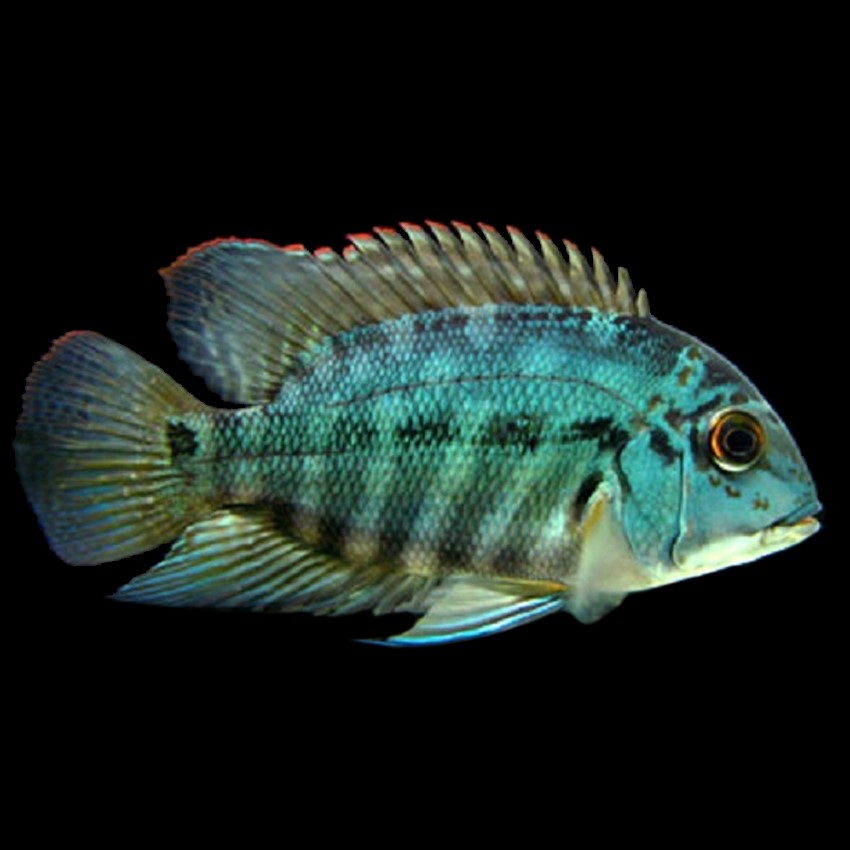
What to feed true parrot cichlid fry
The fry should eat small foods (daphnia, encapsulated rotifers) for the first few days and then move on to freshly hatched brine shrimp for the first few weeks. Once grown out a little bit more, the fry and be fed chopped bloodworms, Spirulina flakes, and micro-pellets. Be careful not to spook the mother with any changes to the environment and wait to do a water change until the fry are separated, or they may be killed.
You shouldn’t start feeding the fry (now that their egg yolk sack is gone) with brine shrimp. Go for smaller food like daphnia or encapsulated rotifers for the first couple of days. Then you can start feeding them hatched brine shrimps. Once they are grown you can start feeding the blood worms, fry pellets, and flakes like Spirulina.
Check the below foods for True Parrot Cichlid Fry:
Diseases of True Parrot Cichlid and how to prevent them
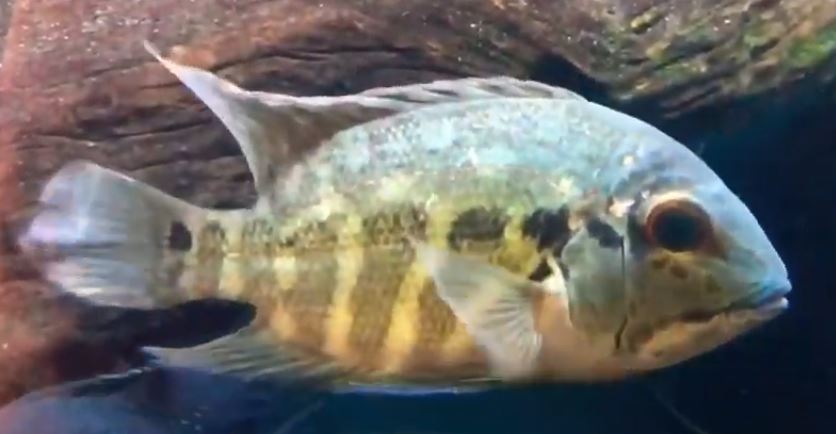
True parrot cichlid can get any common cichlid diseases if not being careful. They are hardy fish but even the strongest fish can get a disease.
Generally, these fish can get swim bladder problems, bloat, internal parasites, and freshwater ich.
Be careful to feed the true parrot cichlid every other day. Don’t overfeed them give them something they can consume in a few minutes. By doing that you can prevent bloat, and maintain a good water quality, which will help to reduce other diseases like ich.
These fish need a large aquarium with great filtration. If you can provide those and maintain the necessary water parameters, then it’s highly unlikely they will get a disease. But you must be careful when adding new members to the tank as they might carry diseases, so always quarantine them for at least 1 to 2 weeks to make sure they are healthy.
Again don’t feed the love fish as it can simply introduce dangerous pathogens into your tank in an instance.
Conclusion
True parrot cichlid is a large predatory fish by our general aquarium standards. It’s indeed an interesting-looking fish that can qualify as a centerpiece of an aquarium. They need big spaces, good filtration, and natural habitat to thrive and to become stress-free. Given these requirements and a mixed diet consisting of a high amount of proteins, you can enjoy a healthy and active fish. if you want other fish with true parrotfish, make sure to choose ones with similar body sizes or more as they can predate on smaller fish. And you shouldn’t ever put smaller invertebrates with these fish unless you want to lose them!




Pingback: Fish Tank 75 Gallon For Beginners - Pet Fish 101